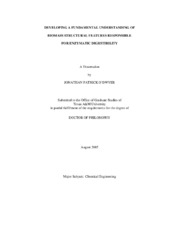| dc.description.abstract | Lignocellulosic biomass is one of the most valuable alternative energy sources
because it is renewable, widely available, and environmentally friendly. Unfortunately,
enzymatic hydrolysis of biomass has been shown to be a limiting factor in the
conversion of biomass to chemicals and fuels. This limitation is due to inherent
structural features (i.e., acetyl content, lignin content, crystallinity, surface area, particle
size, and pore volume) of biomass. These structural features are barriers that prevent
complete hydrolysis; therefore, pretreatment techniques are necessary to render biomass
highly digestible.
The ability to predict the biomass reactivity based solely on its structural features
would be of monumental importance. Unfortunately, no study to date can predict with
certainty the digestibility of pretreated biomass. A concerted effort with Auburn
University and Michigan State University has been undertaken to study hydrolysis
mechanisms on a fundamental level. Predicting enzymatic hydrolysis based solely on
structural features (lignin content, acetyl content, and crystallinity index) would be a
major breakthrough in understanding enzymatic digestibility.
It was proposed to develop a fundamental understanding of the structural features
that affect the enzymatic reactivity of biomass. The effects of acetyl content,
crystallinity index (CrI), and lignin content on the digestibility of biomass (i.e., poplar
wood, bagasse, corn stover, and rice straw) were explored.
In this fundamental study, 147 poplar wood model samples with a broad
spectrum of acetyl content, CrI, and lignin were subjected to enzymatic hydrolysis to
determine digestibility. Correlations between acetyl, lignin, and CrI and linear hydrolysis profiles were developed with a neural network model in Matlab®. The
average difference between experimentally measured and network-predicted data were
±12%, ±18%, and ±27% for 1-, 6-, and 72-h total sugar conversions, respectively. The
neural network models that included cellulose crystallinity as an independent variable
performed better compared to networks with biomass crystallinity, thereby indicating
that cellulose crystallinity is more effective at predicting enzymatic hydrolysis than
biomass crystallinity. Additionally, including glucan slope in the 6-h and 72-h xylan
slope networks and glucan intercept in the 6-h and 72-h xylan intercept networks
improved their predictive ability, thereby suggesting glucan removal affects later-stage
xylan digestibility. | en |


